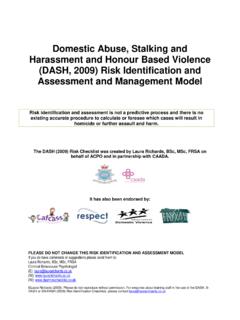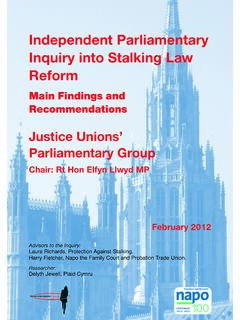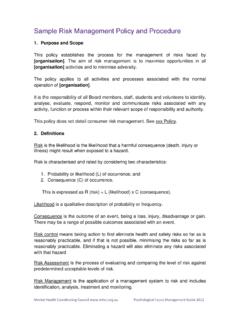Transcription of Domestic Abuse, Stalking and ... - Dash Risk Checklist
1 Laura Richards (2009). Please do not reproduce without permission. For enquiries about training staff in the use of the DASH, S-DASH or SN-DASH (2009) Risk identification Checklists, please contact Domestic Abuse, Stalking and Harassment and Honour Based Violence (DASH, 2009) Risk identification and Assessment and Management Model Risk identification and assessment is not a predictive process and there is no existing accurate procedure to calculate or foresee which cases will result in homicide or further assault and harm. The DASH (2009) Risk Checklist was created by Laura Richards, BSc, MSc, FRSA on behalf of ACPO and in partnership with CAADA. It has also been endorsed by: PLEASE DO NOT CHANGE THIS RISK identification AND ASSESSMENT MODEL If you do have comments or suggestions please send them to: Laura Richards, BSc, MSc, FRSA Criminal Behavioural Psychologist (E): (W): (W): Laura Richards (2009).
2 Please do not reproduce without permission. For enquiries about training staff in the use of the DASH, S-DASH or SN-DASH (2009) Risk identification Checklists, please contact Risk identification for Trained Front Line Practitioners (Please refer to the DASH (2009) Practice Guidance on Risk identification in full) A number of high risk factors have been identified as being associated with serous violence and murder through researching many cases. Any professional using the DASH (2009) must be trained in it s use. This is crucial to understanding what the high risk factors are and how they apply in each situation, and what needs to be done to keep the victim safe. This form should be completed for ALL cases of Domestic abuse by front line staff. Initial risk identification must be undertaken by asking ALL the questions on this Checklist , as well as searching appropriate databases, such as the intelligence databases.
3 First response staff and their supervisor should identify risk factors, who is at risk and decide what level of intervention is required. Details of children resident at the address must be provided. Consider the nature of the information and what it means in terms of public protection - preservation of life, reduction and prevention of harm to victim and others. Please ensure that when you ask these questions the victim is comfortable and understands why you are asking them it is about their safety and protection. Particular sensitivity and attention is required when asking about whether the victim has been assaulted, physically and/or sexually by the perpetrator. The vulnerability of victims cannot be overstated. This could be further compounded by issues such as traditional gender roles, literacy, language and/or immigration or refugee status.
4 Please take into consideration the victim s perception of risk. Please ensure you ask the victim about the abuser s behaviour when Stalking and honour based violence are present. Do not just tick the box yes . You must identify what is happening. There are specific risk factors that relate to these areas as well. Assessment of risk is complex and NOT related to the number of risks appearing alone. Rather, the risk posed to the victim or others in a particular situation will be dependent upon what they are and how they apply in that context. Refer to the full DASH (2009) Practice Guidance on Risk identification . Record what steps you have taken to ensure the immediate safety of the victim(s) and any children. Ask yourself Am I satisfied that I have done all I can?
5 Everything you do must be recorded. The risk identification process must remain dynamic. Events and circumstances may undergo rapid and frequent change. Where this is the case, the assessment must be kept under review. Risk identification is based on structured professional judgement. This model is most effective when undertaken by professionals who have been fully trained in its use. High risk cases may well require a multi-agency response and should be referred to the relevant risk management panel the Multi-Agency Risk Assessment Conference (MARAC) or Multi-Agency Public Protection Panel (MAPPP). MARACs are for the most serious and high risk cases. Laura Richards (2009). Please do not reproduce without permission. For enquiries about training staff in the use of the DASH, S-DASH or SN-DASH (2009) Risk identification Checklists, please contact CURRENT SITUATION THE CONTEXT AND DETAIL OF WHAT IS HAPPENING IS VERY IMPORTANT.
6 THE QUESTIONS HIGHLIGHTED IN BOLD ARE HIGH RISK FACTORS. TICK THE RELEVANT BOX AND ADD COMMENT WHERE NECESSARY TO EXPAND. YES NO 1. Has the current incident resulted in injury? (please state what and whether this is the first injury) 2. Are you very frightened? Comment: 3. What are you afraid of? Is it further injury or violence? (Please give an indication of what you think (name of abuser(s).. might do and to whom) Kill: Self Children Other (please specify) Further injury and violence: Self Children Other (please specify) Other (please clarify): Self Children Other (please specify) 4. Do you feel isolated from family/ friends does (name of abuser(s).))
7 Try to stop you from seeing friends/family/Dr or others? 5. Are you feeling depressed or having suicidal thoughts? 6. Have you separated or tried to separate from (name of abuser(s)..) within the past year? 7. Is there conflict over child contact? (please state what) 8. Does (..) constantly text, call, contact, follow, stalk or harass you? (Please expand to identify what and whether you believe that this is done deliberately to intimidate you? Consider the context and behaviour of what is being done. Ask 11 additional Stalking questions*) CHILDREN/DEPENDENTS (If no children/dependants, please go to the next section) YES NO 9. Are you currently pregnant or have you recently had a baby in the past 18 months? 10. Are there any children, step-children that aren t (..) in the household?
8 Or are there other dependants in the household ( older relative)? 11. Has (..) ever hurt the children/dependants? 12. Has (..) ever threatened to hurt or kill the children/dependants? Domestic VIOLENCE HISTORY YES NO 13. Is the abuse happening more often? 14. Is the abuse getting worse? 15. Does (..) try to control everything you do and/or are they excessively jealous? (In terms of relationships, who you see, being policed at home , telling you what to wear for example. Consider honour based violence and Stalking and specify the behaviour) 16. Has (..) ever used weapons or objects to hurt you? 17. Has (..) ever threatened to kill you or someone else and you believed them? Laura Richards (2009). Please do not reproduce without permission. For enquiries about training staff in the use of the DASH, S-DASH or SN-DASH (2009) Risk identification Checklists, please contact 18.
9 Has (..) ever attempted to strangle/choke/suffocate/drown you? 19. Does (..) do or say things of a sexual nature that makes you feel bad or that physically hurt you or someone else? (Please specify who and what) 20. Is there any other person that has threatened you or that you are afraid of? (If yes, consider extended family if honour based violence. Please specify who. Ask 10 additional HBV questions*) 21. Do you know if (..) has hurt anyone else ? (children/siblings/elderly relative/stranger, for example. Consider HBV. Please specify who and what) Children Another family member Someone from a previous relationship Other (please specify) 22. Has (..) ever mistreated an animal or the family pet? ABUSER(S) YES NO 23. Are there any financial issues?
10 For example, are you dependent on (..) for money/have they recently lost their job/other financial issues? 24. Has (..) had problems in the past year with drugs (prescription or other), alcohol or mental health leading to problems in leading a normal life? (Please specify what) Drugs Alcohol Mental Health 25. Has (..) ever threatened or attempted suicide? 26. Has (..) ever breached bail/an injunction and/or any agreement for when they can see you and/or the children? (Please specify what) Bail conditions Non Molestation/Occupation Order Child Contact arrangements Forced Marriage Protection Order Other 27. Do you know if (.)




